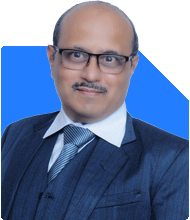Ramalingam Kalirajan |10893 Answers |Ask -Follow
Mutual Funds, Financial Planning Expert - Answered on Jun 20, 2024
He has an MBA in finance from the University of Madras and is a certified financial planner.
He is the director and chief financial planner at Holistic Investment, a Chennai-based firm that offers financial planning and wealth management advice.... more
.jpg)
I am 44, and my income is 81k monthly with follwing expenses: 1) kids education fees 35k 2) kids extra curricular activity charges approx 12k 3) car loan approx 21k 4) Rest is mothly house hold expense for a family of 6 people (Including parents) Please suggest how to plan now for future savings or investments
Understanding Your Current Financial Situation
First, let's assess your current financial standing. Your monthly income is Rs 81,000. Your major expenses are:
Kids' education fees: Rs 35,000
Kids' extracurricular activities: Rs 12,000
Car loan: Rs 21,000
Household expenses for a family of six: Rs 13,000
Your entire income is utilized for these expenses, leaving little room for savings and investments. But, with strategic planning, you can create a robust financial future.
Creating a Budget
The first step towards financial stability is creating a detailed budget.
Track Expenses: Track every expense for a few months to understand spending patterns. Use apps or maintain a diary.
Categorize Spending: Divide expenses into fixed (education fees, car loan) and variable (groceries, utilities). This helps identify areas to cut back.
Set Limits: Allocate specific amounts to each category. Aim to reduce non-essential expenses.
Paying Off Debt
Your car loan is a significant monthly expense. Prioritizing debt repayment can free up funds for savings.
Extra Payments: If possible, make extra payments towards your car loan. This reduces the principal amount and interest burden.
Refinance: Consider refinancing if you find a lower interest rate. This can reduce your monthly EMIs.
Building an Emergency Fund
An emergency fund is crucial to handle unexpected expenses without disrupting your budget.
3-6 Months of Expenses: Aim to save 3-6 months' worth of expenses. This provides a financial cushion.
Accessibility: Keep the fund in a liquid account, such as a high-interest savings account or liquid mutual funds.
Insurance Coverage
Adequate insurance protects your family’s financial future in case of unforeseen events.
Life Insurance: Ensure you have adequate life insurance coverage, ideally 10-15 times your annual income. Opt for a term plan for cost-effective coverage.
Health Insurance: Ensure comprehensive health insurance for the entire family. Consider top-up plans to enhance coverage.
Retirement Planning
Even with current financial commitments, planning for retirement is essential.
Start Early: The earlier you start, the more you benefit from compounding.
Regular Investments: Invest a fixed amount regularly in retirement funds. This could include EPF, PPF, and NPS.
Investing in Mutual Funds
Mutual funds are an excellent way to grow your wealth over time.
SIP Investments: Systematic Investment Plans (SIPs) allow you to invest small amounts regularly. This is ideal for long-term goals.
Diversified Portfolio: Choose a mix of equity and debt funds. Equity funds for growth and debt funds for stability.
Actively Managed Funds: These funds can outperform the market with expert fund managers. They provide higher returns compared to index funds.
Planning for Children’s Education
Education expenses are significant. Plan early to meet these costs comfortably.
Dedicated Funds: Create a dedicated education fund. Invest in a mix of child plans and mutual funds.
Regular Contributions: Contribute regularly to this fund. SIPs in equity funds can provide good returns over time.
Contingency Planning for Parents
With elderly parents in the household, planning for their needs is essential.
Health Insurance: Ensure your parents have adequate health insurance coverage. This reduces the financial burden of medical emergencies.
Emergency Fund: Maintain a separate emergency fund for parents' medical and other needs.
Tax Planning
Effective tax planning helps maximize your income by reducing tax liabilities.
Section 80C: Utilize the Rs 1.5 lakh deduction limit under Section 80C through investments like PPF, EPF, ELSS, and life insurance.
Additional Deductions: Explore other deductions like Section 80D for health insurance premiums and Section 24 for home loan interest.
Regular Financial Reviews
Regularly reviewing your financial plan ensures it remains aligned with your goals.
Annual Reviews: Conduct a comprehensive review of your finances annually. Adjust investments and budget as needed.
Life Changes: Update your financial plan to accommodate changes like a salary hike, new investments, or changes in family structure.
Consulting with a Certified Financial Planner
While you can manage your finances effectively, consulting with a Certified Financial Planner can provide personalized advice and strategies.
Tailored Advice: A CFP can provide advice specific to your financial situation and goals.
Holistic Planning: They can help create a comprehensive plan covering all aspects of your financial life.
Implementing a Savings Plan
Creating a disciplined savings habit is key to financial security.
Automate Savings: Set up automatic transfers to your savings and investment accounts. This ensures regular contributions.
Incremental Increases: Increase your savings rate gradually, especially with salary hikes or bonuses.
Investment in Children’s Future
Sukanya Samriddhi Account: If you have daughters, this is a good long-term savings scheme with tax benefits.
Children’s Plans: Consider plans specifically designed for children’s future needs, which combine insurance and investment.
Emergency Planning
Life can be unpredictable. Having a contingency plan is crucial.
Wills and Nominations: Ensure all your investments and insurance policies have updated nominations. Draft a will to outline the distribution of assets.
Power of Attorney: Assign a trusted person to handle financial matters if you’re unable to do so.
Health and Wellness Investments
Investing in health and wellness can prevent high medical costs in the future.
Regular Check-ups: Schedule regular health check-ups for the entire family. Early detection of health issues can save costs.
Healthy Lifestyle: Encourage a healthy lifestyle with a balanced diet and regular exercise. This reduces medical expenses and improves quality of life.
Planning for Major Expenses
Plan for major future expenses like children's marriage or buying a new car.
Specific Funds: Create specific funds for these goals. Invest according to the timeline and risk appetite.
Regular Contributions: Contribute regularly to these funds to build a corpus over time.
Educational Loans
For higher education expenses, consider educational loans which come with tax benefits.
Loan Options: Explore various loan options. Educational loans often have lower interest rates and flexible repayment terms.
Tax Benefits: Repayment of educational loans qualifies for tax deductions under Section 80E.
Enhancing Income
Exploring additional income streams can boost your financial situation.
Part-time Work: Consider part-time work or freelance opportunities in your field.
Investing in Skills: Invest in acquiring new skills or certifications to enhance career growth and salary potential.
Building Assets
Focus on building assets that generate passive income.
Mutual Funds and Stocks: Continue investing in mutual funds and stocks for capital appreciation.
Bonds and FD: Consider bonds and fixed deposits for stable returns and capital preservation.
Evaluating Financial Products
Always evaluate financial products carefully before investing.
Understand Charges: Look into charges and fees associated with financial products. High fees can eat into your returns.
Risk Assessment: Assess the risk involved in any investment. Ensure it aligns with your risk tolerance and financial goals.
Final Insights
Your proactive approach to managing expenses and supporting your family is commendable. By creating a detailed budget, prioritizing debt repayment, building an emergency fund, ensuring adequate insurance, and investing wisely, you can secure your financial future. Regular reviews and consultations with a Certified Financial Planner will keep you on track to achieve your goals. Implement these strategies diligently to create a financially secure and prosperous future for your family.
Best Regards,
K. Ramalingam, MBA, CFP,
Chief Financial Planner,
www.holisticinvestment.in
You may like to see similar questions and answers below
Ramalingam Kalirajan |10893 Answers |Ask -Follow
Mutual Funds, Financial Planning Expert - Answered on Apr 30, 2024
Ramalingam Kalirajan |10893 Answers |Ask -Follow
Mutual Funds, Financial Planning Expert - Answered on Jun 24, 2025
Ramalingam Kalirajan |10893 Answers |Ask -Follow
Mutual Funds, Financial Planning Expert - Answered on Jul 07, 2025
Ramalingam Kalirajan |10893 Answers |Ask -Follow
Mutual Funds, Financial Planning Expert - Answered on Aug 02, 2025
Ramalingam Kalirajan |10893 Answers |Ask -Follow
Mutual Funds, Financial Planning Expert - Answered on Aug 28, 2025
Nitin Narkhede |113 Answers |Ask -Follow
MF, PF Expert - Answered on Dec 15, 2025
Nitin Narkhede |113 Answers |Ask -Follow
MF, PF Expert - Answered on Dec 15, 2025
Ramalingam Kalirajan |10893 Answers |Ask -Follow
Mutual Funds, Financial Planning Expert - Answered on Dec 15, 2025
Ramalingam Kalirajan |10893 Answers |Ask -Follow
Mutual Funds, Financial Planning Expert - Answered on Dec 15, 2025
Radheshyam Zanwar |6746 Answers |Ask -Follow
MHT-CET, IIT-JEE, NEET-UG Expert - Answered on Dec 15, 2025
Ramalingam Kalirajan |10893 Answers |Ask -Follow
Mutual Funds, Financial Planning Expert - Answered on Dec 15, 2025
Ramalingam Kalirajan |10893 Answers |Ask -Follow
Mutual Funds, Financial Planning Expert - Answered on Dec 15, 2025
Ramalingam Kalirajan |10893 Answers |Ask -Follow
Mutual Funds, Financial Planning Expert - Answered on Dec 15, 2025
Samraat Jadhav |2508 Answers |Ask -Follow
Stock Market Expert - Answered on Dec 15, 2025
Ramalingam Kalirajan |10893 Answers |Ask -Follow
Mutual Funds, Financial Planning Expert - Answered on Dec 15, 2025

























